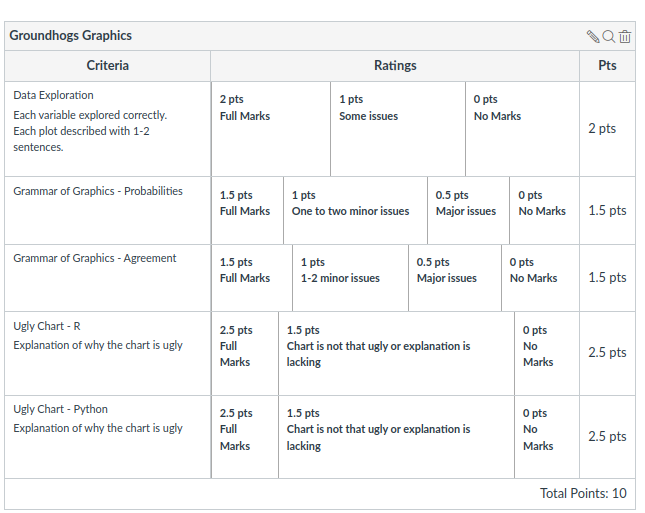Creating Good Graphics
2025-02-20
Survey Results
- What is helping me to learn in this class?
textbook for reading quiz
trouble-shooting in class
work time in class
examples in class
talking with classmates
- What am I doing to improve my learning in the course?
ask questions
starting homework early, think about it during the week
look things up: textbook, resources outside the class (videos, other articles)
check homework before class to see if there are immediate questions
- What changes are needed in this course to improve learning?
More clarity -
How does homework tie in with requirements?
clearer materials
Sample solution for homework
- What do I need to do to improve my learning in this course?
Ask more questions
Practice coding
Do readings earlier, try to absorb more information from readings
Be more present in class/pay better attention
Some Logistics
Homework #5 due date: Thursday night (11:59 pm)
All subsequent due-dates for homework assignments will be Thursday night
Keep due-dates for readings and quizzes on Tuesday
Plan for Thursdays: - if there are questions on the current homework assignment, work on that, - start on the new assignment
Homework: Graphics
How does the homework tie to the readings?
Working on skills: how to make graphics
Work on concepts: what are mappings, and how do they effect the conclusions
Work on presentation: what are more effective ways of presenting information
Homework rubric

Graphics week homework
Part I: Make visual summaries for two new data sets and think about mappings
Part II: Use your knowledge to create the worst!
Data Exploration
Make charts for all variables that are listed by name:
groundhogs.csv
- lat, long
- country
- isGroundhog
- active
- predictionsCount
predictions.csv
- isGroundhog
- year
- shadow
Variable active

This is a barchart of the variable active, the variable is mapped to the x axis, the count for each bar (corresponding to the height of the bars) is mapped to y. Finding: Very few (2) groundhogs are not active.
Probabilities and Agreement
Answer the following two questions using charts. Explain your chart, and explain how it answers the question.
Do different groundhogs have different probabilities of predicting 6 more weeks of winter?
How much do North American groundhogs tend to agree on their predictions?
Do different groundhogs have different probabilities of predicting 6 more weeks of winter?
predictions <- read.csv("https://raw.githubusercontent.com/stat-assignments/eda-groundhogs/refs/heads/main/groundhog-predictions.csv")
predictions %>%
mutate(name = reorder(factor(name), name, length)) %>%
ggplot(aes(x = name)) + geom_bar() +
geom_bar(aes( weight = shadow), fill = "darkorange") +
theme(axis.text.x = element_text(angle = 60, hjust = 1)) +
ggtitle("Number of predictions\nNumber of times seeing a shadow in orange")
What about missing values in the shadow variable?
How do we need to change the previous chart?
predictions <- read.csv("https://raw.githubusercontent.com/stat-assignments/eda-groundhogs/refs/heads/main/groundhog-predictions.csv")
predictions %>%
filter(!is.na(shadow)) %>%
mutate(name = reorder(factor(name), name, length)) %>%
ggplot(aes(x = name)) + geom_bar(aes(fill=factor(shadow)), position = "fill") +
theme(axis.text.x = element_text(angle = 60, hjust = 1)) 
limitations: different groundhogs have made very different number of predictions (and for different years)
How much do North American groundhogs tend to agree on their predictions?

For years since 2010 … in each year close to 50/50 shadow/noshadow prediction - that’s the least amount of agreement we can possibly get!

But … when we color points by prediction, there seems to be regional agreement

Is this perceived agreement real?
Which plot shows the most geographic agreement?

year was 2023 data is in 2
… maybe there is not even regional geographic agreement between the predictions.
Lineups help us to calibrate our eyes and distinguish random patterns from real visual findings.
Resources for this week
Ugly Chart Challenge variant example from last semester’s graduate class
-
- Also an RStudio addin package -
ggThemeAssist
- Also an RStudio addin package -
Homework
- Explanations! What can you see from the plot? What is its purpose?
Next time
Continue working on homework assignment
Brainstorming: 🧠⛈️
- how to make the textbook 📖 more effective
- what will motivate you to read it before class? 😜